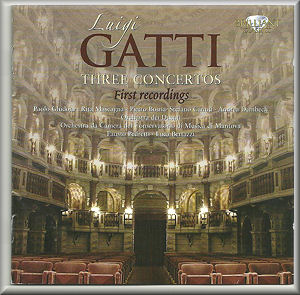 |
 |
|


alternatively
CD: MDT
AmazonUK
AmazonUS
|
Luigi GATTI
(1740-1817)
Concertone in D for 2 violins and orchestra, L7e.1 (1769) [23:51]
Concerto in F for bassoon and orchestra, L7e.4 (?1795) [19:12]
Concerto in C for piano and orchestra, L7e.5 (c.1790-1794) [26:16]
 Paolo Ghedoni, Rita Macagna (violin), Pietro Bosna (cello: 1) Stefano
Canuti (bassoon); Andrea Dembech (piano)
Paolo Ghedoni, Rita Macagna (violin), Pietro Bosna (cello: 1) Stefano
Canuti (bassoon); Andrea Dembech (piano)
Orchestra dei Ducati/Pausto Pedretti (1)
Orchestra da Camera del Conservatorio di Musica di Mantova/Fausto
Pedretti (2) Luca Bertazzi (3)
rec. 22 December 2008, Mantua Cathedral (1) 4 July 2009, Palazzo
Ducale, Mantua (2); 1 September 2009, Teatro Bibiena, Mantua (3)
 BRILLIANT CLASSICS 94146 [69:19]
BRILLIANT CLASSICS 94146 [69:19] 
|
|
|
In terms of later reputation, holding appointments in Salzburg
has proved a decidedly mixed blessing for many a composer. Pretty
well all of them have been utterly cast into the shadows – deservedly
or otherwise – by Mozart. The life and works of Mozart now so
completely constitute the ‘myth’ by which Salzburg defines itself
– from Mozartkügeln to the Mozarteum, from Papagenoplatz (with
its statue of the bird-catcher) to the Café Pamina – that for
any other composer to be associated with Salzburg seems like
a silent guarantee of unimportance. Even substantial composers
such as Heinrich Biber (1644-1704), Georg Muffat (1653-1704)
and Michael Haydn (1737-1806) are underrated in part because
of the ‘Mozart effect’ - it is exceedingly difficult to find
the tiny Michael Haydn museum in Salzburg actually open for
visitors. Others, such as Giuseppe Francesco Lolli (1701-1778),
Johann Ernst Eberlin (1702-1762), Franz Ignaz Lipp (1718-1798)
and Joseph Hafeneder (1746-1784) might have been a good deal
better known had they made their careers elsewhere. Luigi Gatti
does at least seem, in recent years, to be attracting the sort
of attention that may bring his music out from beneath the large
shadow of Wolfgang Amadeus. He has been the subject of extensive
research by Alessandro Lattanzi and others at the Mantua Conservatory
– the first volume of a Thematic Catalogue was published in
2010. Conferences on Gatti – along with performances of music
newly edited from manuscript – were held in Mantua in 2010 and
in Salzburg in March of 2011.
Gatti was born at Lazise, on the eastern shore of Lake Garda.
While the composer was still young the family moved to Mantua.
It was there that Gatti took holy orders and proceeded to make
a considerable reputation as a musician, as a singer and instrumentalist
and as a composer. In 1773 he became primo maestro di capella.
From 1768 onwards he had contributed very popular operas to
the Mantuan stage. Though first approached as early as 1778,
it was in 1782 that Gatti that he accepted an appointment from
Archbishop Hieronymus Colleredo as Kapellmeister of Salzburg
Cathedral - a position to which Leopold Mozart aspired and for
the acquisition of which he never forgave Gatti. He held the
post until his death on 1 March 1817.
Such music of Gatti’s as I had previously heard did not indicate
a composer of any great originality; but it certainly suggested
that Gatti had an assimilative and articulate musical mind,
high technical competence and a genuine gift for lyricism. These
qualities are evident, to varying degrees in the three works
which receive their world premieres on this attractive disc.
The Concertone is a relatively early work, written and premiered
in Mantua when Gatti was in his late twenties. It is a pleasant
if essentially conventional work, tuneful and charming without
any great profundity; the dialogue between the two solo violins
is generally engaging and there are times when the prominence
given to the cello comes close to making this a triple concerto.
The first movement has some longueurs, but the larghetto espressivo
which follows has a lyricism which speaks of its composer’s
accomplishments as a man of opera and its interplay of solo
voices produces some lovely moments. The closing allegro is
full of vitality, public music of some sophistication and vigour.
The other two works on the disc belong to Gatti’s years in Salzburg
and they show – most notably in the case of the piano concerto
– that Gatti was continuing to develop as a composer. The concerto
for bassoon and orchestra is a very assured piece – woodwinds
often seem to bring the best out of Gatti, his writing for oboe
elsewhere being equally impressive. The writing here calls for
some fair agility from the soloists and contains a number of
appealing melodies, not least in the opening allegro spiritoso.
The central slow movement - marked ‘Romance: Adagio sostenuto’
- has a lyrical serenity which is striking. Unfortunately the
final movement is incomplete in the surviving score and has
had to be reconstructed - in an idiomatically convincing fashion
- by Giordano Fermi. It is in the piano concerto in C that,
as Alessandro Lattanzi observes in his booklet notes, one hears
Gatti’s familiarity with the example of the young Mozart and
also some anticipations of the next generation of composers.
Along with the bassoon concerto this is a work that makes one
eager to hear more of Gatti’s music. The elegance of structure
and the harmonic subtlety, as well as some attractive melodic
writing sustain one’s interest and reward one’s attention through
all three movements.
Though one might imagine even finer performances than these
on the present disc, there is a great deal to enjoy here and
none of the soloists, conductors and orchestras do anything
other than put a persuasive case for Gatti. One hopes, indeed,
that they will return to his music for some future CDs.
Glyn Pursglove
|
|

